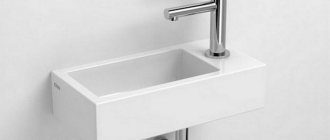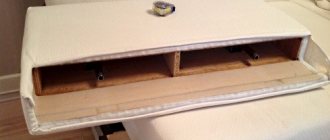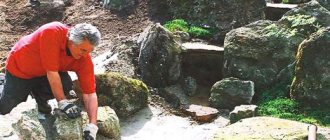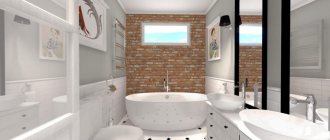Plumbing in a dacha is a luxury that not everyone can afford. Difficulties in supplying water to the site can have different sources: the distance of the main water supply from the dacha, the impossibility of laying pipes, the high cost of equipment/plumbing, and much more. But in a summer cottage there is a constant need for water - to rinse your hands, to wash your face, or to wash the dishes. And the salvation in this case is a small country washbasin, which, by the way, is quite easy to make with your own hands.
DIY country washbasin
Features of country washbasins
A washbasin that can be used for a summer residence is generally a small structure that does not have a connection to water supply or sewer pipes, but performs simple functions that enable the user to maintain the proper level of hygiene of the body and home. So, usually the structure of a washbasin consists of only a water tank and a small sink (and in some cases there is none). The latter can be hung on the wall or installed on a cabinet. The water container can have different volumes - this will determine how often you will have to fill the tank in order to use the washbasin. However, such designs are not particularly large in size.
Design of a self-assembled country washbasin
Washbasin for a summer residence with a drainage channel
Typically, the washbasin tank is filled with water as needed. To use it, you need to open the tap or press a special lever, and the water will flow. Once the tank is empty, you can refill it with water and use the sink.
Original heated country washbasin
On a note! Typically, country washbasins are installed on the street near the house or bathhouse. But some design options can also be installed indoors, provided that proper drainage of used water is organized.
A dacha is a great place to relax, but don’t forget about gardening work.
You can use a dacha washbasin in the following cases:
- the need to rinse your hands after dacha work;
- washing hands and face to maintain hygiene;
- washing dishes;
- rinsing small items.
Heated washbasin for a summer residence
Due to its small dimensions and small volumes of water, it will not be possible to use a washbasin for larger purposes (for example, taking a shower).
Washbasin for a summer residence - decor
Advantages of a country washbasin:
- ease of installation anywhere;
- ease of making with your own hands;
- small dimensions;
- simplicity and ease of use;
- mobility - the washbasin can be easily moved to another place if necessary;
- the water in it quickly heats up under the rays of the sun - you can use warm water. However, there are country washbasins with the ability to heat water.
Simple plastic washbasin (washstand)
Disadvantages of this design:
- the need to frequently collect water;
- in cold weather, the water in the sink will remain cold;
- for the winter it must be emptied and removed from the street, otherwise it may be damaged;
- impossibility of full connection to the water supply and sewerage system.
The cheapest and easiest way to make a country washbasin
Simple washbasin with cabinet and sink
Which technology is easier to master on your own?
If we talk about making it ourselves, the easiest way is to make a tabletop from cast acrylic. True, if you use ready-made mixtures, the price will be almost the same as when ordering from a company. The next most complex process for making countertops is from agglomerate. Since there is only a small amount of binder, achieving a smooth front surface is not so easy. If you don’t mind long grinding to get a normal result, you can try to master this technology. A countertop made of artificial stone based on agglomerate is the best choice in terms of durability and appearance.
DIY artificial stone countertop
The latest “lightest” countertop manufacturing technology is made from sheet stone. A lot of precise cutting, gluing parts and sanding. You need professional tools - a circular saw with guides, a jigsaw, a disc grinder with a set of polishing discs. A lot of clamps are also required to attract and fix the glued fragments.
Types of designs
Despite the fact that when most people mention the phrase “country washbasin,” they imagine a small tank installed on the wall of the house, there are a lot of varieties of this type of design. And they differ not only in the color and material from which they are made, but also in size, appearance and even a number of design features.
On a note! Among country washbasins, there are the most primitive options and, at the same time, complex designs that have the function of heating water or unusual decorative design.
Outdoor washbasin
Table. Summary table of types of washbasins.
| Type | Short description | Subspecies |
| Street | Such washbasins, as you might guess, are installed outdoors. Usually these are suspended structures, fixed to a wall or some kind of support, and may not have a sink (in this case, the water simply flows to the ground). They are small in size and easy to use. There is no water heating function (warm water can only be used on sunny days, when the liquid is heated by the thermal energy of the sun). | They have one standard option - the one that hangs on the wall. The only differences here can be in the materials, shape, dimensions of the product and the method of water supply. |
| Home type | These washbasins are installed indoors - in a bathhouse, at home, on a veranda, etc. They usually have a more complex design, since here it is necessary to think through a water drainage system (it can be discharged either into a container, which is then emptied, or into a pipe, connected to a cesspool or taken outside the house to the site). Also, this version of washbasins suggests, in some cases, the possibility of supplying water to the container to be filled and the possibility of heating the liquid. | Such washbasins can be divided into 4 categories: on a counter, with a cabinet, with a filling system, and with a water heating function. |
Washbasin with heated water for a summer residence
As for the materials used to make washbasins, plastic, stainless steel and sometimes wood are usually used. The latter is used less and less, since two other materials surpass it in performance characteristics. For example, a steel washbasin can last for many years without damage, plastic is absolutely not afraid of water, etc. When choosing a material, you should focus only on your own preferences and wishes in general. Below we will take a closer look at some types of washbasins.
The washbasin can be placed next to the beds
DIY washbasin from scrap materials
Self-leveling washbasin
This option can also be called hanging. This is the simplest model, consisting of a small water tank, fasteners and a tap for the ability to turn on or off the water. This type of washbasin works like this: the tank is filled with water manually, then you just need to open the tap or use the pressing mechanism, and the liquid is ready for use. Caring for the tank is extremely simple - you just need to regularly clean it from the inside to remove sediment and remove it from the street for the winter.
Plastic wall-hung washbasin
On a note! The capacity of such a washbasin usually does not exceed 3-5 liters of water. You can mount it on a house, on a tree – in general, on any vertical surface.
This option is excellent for ensuring a primitive level of hygiene - rinsing hands and washing. It is usually mounted outdoors in an accessible place for use. Installing it couldn’t be easier, and such a tank costs mere pennies. By the way, you can ensure the presence of such a washbasin in your dacha even without going to the store - it’s very easy to make it yourself.
Scheme of a washbasin made from a plastic bottle
A simple pour-over washbasin can be made from a plastic bottle
The drain can be organized in any way you like: install a sink, and under it an old bucket, run a pipe, or simply allow the water to flow to the ground. By the way, it is recommended to pour gravel into the place where water will seep underground.
There are pour-over washbasins and much larger volumes - up to 18 liters. There is enough water in them, including for washing dishes. They can have different shapes, are usually made of plastic or metal, and always have a valve to prevent sudden leakage of water. You can install such a tank in the house or on the street, the main thing is to securely fasten it on a vertical surface.
A canister washbasin is a great option for the garage
Washbasin with cabinet
The head of the washbasin and the commander of the washcloths... That’s right, this type of washbasin, equipped with a cabinet, is popularly called “Moidodyr”, which Korney Chukovsky once wrote about. Such a washbasin looks massive and stable, and it can be installed both indoors and outdoors (you can see it more often in the house). The design is a wooden cabinet equipped with a sink and a water tank. There is also a small cabinet where you can store personal hygiene items.
Country washbasin with cabinet
The water tank of such a washbasin usually has a good large volume. You can fill it either manually or supply water through pipes. You can install a bucket inside the cabinet to collect used water. It's important to remember to take it out. The main advantage of this “Moidodyr” is the ability to conveniently wash dishes, and not just wash or rinse your hands.
Attention! If “Moidodyr” is located outside, then it is important to put it indoors for the winter so that the wood from which the cabinet is made does not become unusable. Also, you should not place such a structure in direct sunlight - the material may dry out and become deformed.
In a summer cottage, even with water supply, a washstand is a vital thing
Washbasin on counter
This is a greatly simplified version of “Moidodyr”, it is a structure of a support, a tank and sometimes a sink. The tank and sink are simply fixed on a stand, usually metal. The legs of the support are dug into the ground. The advantage is that you can install such a structure anywhere in the garden.
Washbasin on a counter from an old washing machine
Country washbasin idea
This version of the washbasin is used outdoors. It is stable and easy to use. The volume of the water tank is up to 15 liters. Usually the tank itself is equipped with a valve, so washing your hands using such a washbasin is very convenient.
Do-it-yourself washbasin for your dacha. Making a simple and convenient drain
Washbasin with heating
This option is the best from a landscaping point of view. After all, you can use not cold water, but heated and even hot water. Such washbasins are equipped with special heating elements that heat water and operate on the principle of a boiler - the tank must be filled with liquid and the equipment must be plugged into the network. After a while the water will warm up and it can be used
The heater can be immersed in water or located in a separate pipe in the tank. Cheaper is option number 1, and therefore it is used more often. But in this case, the tank will have to be descaled, and you need to use the washbasin carefully - the structure may cause an electric shock if it is damaged.
Country washbasin with cabinet and water heating
Popular models
Unique Wood Design
The following brands were among the first to create wooden plumbing fixtures:
- Unique Wood Design (Poland). The company's history began with the construction of yachts and rowing boats. Subsequently, the experience of working with wood was used to create bathroom equipment. The “Classic” collection consists of the usual oval, smoothly rounded bathtubs and washbasins. The Tlon line, which includes rectangular and square sinks, is designed for modern interiors.
- Ammonitum (Switzerland). A characteristic feature of all models is the deliberately striped pattern of the wooden surface. It resembles the spiral shell of the ancient ammonite mollusk after which the brand is named. The most recognizable washbasin models are Conos, Taurus, Bootes, Vela.
- A Legna (Switzerland). The Laguna Pure collection features wooden sinks in rectangular and round shapes. The pattern of tree rings is arranged in such a way that the sinks resemble blooming tropical flowers.
In industrial production, veneer sheets are used to make sinks, which are impregnated with a special moisture-proof resin and then glued together under high pressure.
Product selection
Everything is simple here - you need to choose products depending on the specific needs of a person for clean water. For installation in a greenhouse, the simplest washbasin is sufficient, which you can even make yourself. But in the house, if funds allow, it makes sense to install a washbasin with the ability to heat water - washing and washing dishes will be much more pleasant.
Wastewater disposal
As for the volume of water consumed, you need to take into account the number of people who will use the washbasin, as well as the frequency of use. So, for one summer resident a small washbasin with a capacity of 5 liters is quite enough, but if several people live in the house or work on the site at once, then it is recommended to install a structure with a volume of at least 10 liters.
Choosing the best washbasin for your cottage
As for the material, you should focus on your preferences. The metal is stronger, more durable, does not fade, but will rust over time. Plastic is not subject to corrosion, but is more fragile and can fade under the sun. But it is quite inexpensive. Wood is used if a cabinet is needed under the washbasin. It is not recommended to make a tank out of it.
The photo shows another version of the cabinet, in the manufacture of which wooden boards were used
The most convenient types of washbasins for the dacha are portable models
To the question “Make or buy?” everyone must answer for themselves too. So, the simplest washbasin can either be bought for little money in a store or made from some container in an hour. But complex designs with a cabinet are easier to buy. Although, if you wish, you can do them yourself. Below we will look at several options for creating simple washbasins for your dacha.
Decorating a country washbasin
On the counter
A more complex option is a country washbasin on a counter. They are containers mounted on a “leg”. This option is convenient to move and install around the site.
Some designs have a baffle on the vanity support, making installation easier by pressing down on it with your foot. Those parts of the installation that are immersed in the ground must be insulated from moisture.
Making a washbasin from a plastic bottle
Step 1. First, you should take everything you need to create such a simple washbasin. This is a large 5 liter plastic bottle, marker, scissors, water-resistant glue, plasticine, hose connector.
Tools and materials needed to make a washbasin
Step 2. Next you need to modify the hose connector. Its valve needs to be weighted. In order to do this, you need to take the marker, disassemble it and leave the marker body. Meanwhile, you need to remove the valve itself from the connector and remove the rubber seal from it.
Disassembled marker and valve from connector
Step 3. The marker tube needs to be filled with plasticine and compacted well. This is necessary so that the valve itself in the future washbasin shuts off the water well. You then need to insert the valve itself inside the marker body, gluing it with waterproof glue.
A valve is inserted inside the marker
Step 4. Next you need to take a bottle - the future water container - and screw off the lid. The connector will need to be built into the cover by cutting a hole in it with the same diameter as the connector thread. The thread must be coated with sealant or glue and screwed into the lid. The thread must be inside.
The thread is lubricated with sealant
Step 5. The hose connector nut must be screwed on from the inside of the cover and the glue must be thoroughly dried. Next, you can insert the valve into the connector and install the rubber seal in place.
Now you can insert the valve
Step 6. You need to cut a hole in the bottom of the bottle-container to fill the water. The easiest way to organize this place is to take a plastic bottle of a smaller volume and cut off the top of it, which will serve as a funnel and lid for the washbasin.
The top of the smaller bottle is cut off
Step 7. This washbasin was mounted on wood. It can be tied to the support using twine, which can be secured with tape on the tank itself. You can also wrap the bottle with twine and use it to hang the washbasin on a nail on the wall.
The twine is fixed with tape
You can also wrap the bottle with twine
Step 8. The bottle cap with the valve must be screwed to the tank, secure the latter to the support, and the washbasin is ready for use.
Screw on the lid with valve
how to make a hole in a brass basin?
Good day! I have an idea to make a sink out of a brass basin, but I don’t know how to make a hole for the drain. After all, the hole should have a recess (like on metal sinks in kitchens) so that water does not remain in the sink. I would appreciate your advice. Or maybe someone can tell me where this can be done in a more civilized manner) And another question, how to treat brass so that it does not darken from water?
About the recess with a hole for release. Mark the place with a marker. Take a piece of pipe with an internal diameter 5-10 mm larger than the outlet neck. The edge of the pipe should be straight and smooth with a chamfer removed. Place the bottom of the basin on the end of the pipe in the place where you need to make a recess for the hole. Gently hit the center of the intended recess with a round-faced hammer. The blows should be weak and centered. That part of the bottom of the basin that covers the inner diameter of the pipe should form something like a funnel. When the depth of this recess becomes approximately 7-10 mm, you can drill a hole for the outlet. You can treat brass with varnish or a special patination agent, depending on what kind of surface you need.
Washbasin made from a bottle and syringe
An even simpler option is to create a homemade washbasin from an ordinary plastic bottle.
Step 1. First of all, you need to unscrew the cap from the bottle and cut a hole in it with the same diameter as the syringe you took. A 2.5 cc syringe is ideal.
You need to cut a hole in the cap for the syringe.
Step 2. Next, you need to cut off the spout of the syringe on which the needle is placed. Moreover, not only the spout itself needs to be removed, but also the entire upper part.
The syringe tip needs to be cut off
Step 3. Then the syringe must be inserted into the hole in the bottle cap. It is important that the syringe barely fits into the hole, otherwise it will have to be sealed with sealant to prevent water leaks.
Syringe inserted into hole
Step 4. The stopper with the syringe can be screwed back onto the bottle. The bottom of the container must be cut to allow it to be filled with water.
The cap screws onto the bottle
Step 5. Now the washbasin can be installed and used. To shut off the water, the syringe plunger must be pulled out.
The syringe plunger is pulled out
And in this position of the piston the washbasin can be used
Attention! Large bottles are not recommended in this case. Otherwise the design will be unreliable. A volume of 2-3 liters is quite sufficient.
Customer Reviews
Konstantin, Moscow : “My wife wanted a bathroom in an ecological style. The floor and walls were finished with boards, and a shower system a la a tropical shower was installed. But there was still no highlight. And then I decided to order a wooden sink. This is such a miracle! It is executed perfectly, smooth, smooth shapes. Washing your face in the morning is a pleasure!”
Irina, Moscow : “I had a dream - a wooden bathtub. So that, as in advertising, you can bask there in the foam and rose petals. But such baths cost exorbitant prices! So I decided to buy myself a wooden sink. And now every morning starts with a smile. I really like the way this sink looks. I love touching its glossy surface. Following the sink, I wanted to buy more wooden items for the rest of the apartment.”
Washbasin made from an oil canister
Another simple washbasin option that motorists can make without throwing away the oil canister and purchasing a water bottle with a shut-off valve plug.
Step 1. The first step is to take a metal canister and rinse it well.
The canister must be rinsed thoroughly
Step 2. You will also need to take the neck of a plastic bottle. It needs to be attached to the canister in the place where the water outlet will be organized, that is, the tap, and circled with a marker.
The neck of the bottle is outlined with a marker
Step 3. Using the resulting contour, you need to cut a hole in the tank. You can use a drill and drill a few holes to make the cut.
Holes are drilled with a drill
Cutting a hole in the canister
Step 4. The sharp edges of the hole need to be sanded with a file.
The edges of the hole are sanded
Step 5. Using cold welding, you need to attach the plastic neck of the bottle, which was previously used to apply markings, to the tank by inserting it into the hole.
Plastic bottle neck
The neck is inserted into the hole
Step 6. Now you need to screw the bottle cap, equipped with a valve, onto the neck - this will be the tap.
The future faucet of a country washbasin
Step 7. Having filled the tank with water, you can use the washbasin by opening and closing the water using the valve.
Ready-made country washbasin from a canister
Classical
As a classic washbasin, a metal container is used, in which a sufficient hole is made on top to pour water inside.
A hole is also made from the bottom for the valve; by pressing on it, water will flow out through the hole. The simplest design is hung on hooks on the wall, it is very easy to make yourself in just 15 minutes.
How to choose and install it yourself
When choosing a model in a store, you need to be guided by the following arguments:
- season of use, heating will be required or not;
- street or home mode of operation affects the choice of material;
- tank size based on the number of users;
- case design.
Having determined these criteria, it is enough to simply select and install a washbasin in your dacha with your own hands. The main task is to securely fasten the water tank to the support. If this is a ready-made model with a housing, you need to follow the instructions exactly and firmly secure the tank to the panel, this will ensure safety of use.
Self-placement will help you implement a set of terminals and fasteners, which are included in the sales kit. The frame is purchased ready-made or made from available material. The metal legs of the frame are sunk into the ground in proportion to the weight of the filled water container - the heavier, the deeper. The height of the frame is calculated based on proportionality to the height of the person, but so that the tank hangs at least 1 meter from the ground.
For greater stability, the frame is made in the form of a cabinet. It is made as follows: prepare corners from steel 25x25, or wooden beams with a section of 50x50. Measure the dimensions of the sink and calculate the dimensions of the frame. Parts are cut to the required length from a metal profile or timber and screwed together or manually welded.
If you want to make a closed structure, the frame is covered with wooden slats, chipboard or MDF panels or plastic and a sink is installed.
Plastic frame sheathing is a more practical option for outdoor use. The cabinet can be coated with moisture-resistant paint. It is worth noting that the paint on the outdoor washbasin will have to be updated annually. Chipboard and MDF panels are only suitable for home use. To extend the service life of the frame, you need to isolate the legs from soil moisture. To do this, the metal is painted with an anti-corrosion compound, and the wooden parts of the structure are treated with anti-rotting agents. Water drainage is organized either autonomously - in a bucket under the sink, or permanently - in a drainage hole. For stationary drainage, a sewer drain pipe is installed in the rear part of the cabinet.
The back wall is built with a vertical frame on which a water tank, mirror and towel hooks will be mounted. The side walls of the cabinet are covered with panels, the back wall can also be covered with a panel, and when installed against a wall, it is left open. The door is hung on hinges on the front wall of the cabinet or left open; if desired, this place can be decorated with a curtain. It is better to place an outdoor washbasin on a hard paved area.
It’s not difficult to make a heating system yourself; you just need to purchase a heating element of the required power. It must correspond to the size of the water tank. It is better to opt for models with a thermostat. Attach the heating element to the side wall of the tank at the bottom of the container. The upper location will make heating less efficient; the heating element will often burn out due to a decrease in the water level. Installing a heating element requires careful insulation of the terminals and wires.
Well-known manufacturers and reviews
Well-known Russian manufacturers offer a wide range of ready-made country washbasins that meet the diverse needs of consumers and have a wide price range. The most popular heated models are Elbet washbasins - inexpensive devices with a powerful water heating element, temperature sensors and a large water capacity. According to reviews from summer residents, they have good performance.
The “Spring” washbasins are not inferior to them in quality. They are made of stainless steel, which significantly increases their service life. Both heated and non-heated models are available; the tank has a volume of 16 liters or more.
“Sadko” is a compact model with a polypropylene body; the water tank holds more than 18 liters. Consumers note the ease of assembly and installation, convenient and durable fastening of structural parts.
Good washbasins are offered by the following: “Dachnik”, “Chistulya”, “Double”, “Leader”, “Waterfall”, Obi. The products have gained popularity due to their good quality and budget prices. Washbasins have a variety of designs, a tank volume of over 20 liters and heating. When choosing a model, you need to pay attention to the heating method. “Dry” heating is provided by a soapstone pipe with a heating element inserted into it. This method allows you to heat water quickly and without scale formation; they do not break when connected without water. “Wet” heating is similar to the operation of a boiler; it is less safe and more prone to breakdowns, which makes the price of such washbasins somewhat lower.
Do-it-yourself wooden “moidodyr”
To make a more complex stationary structure, which will be not only a functional, but also a decorative element of the site, you will need 25x150 mm boards. The dimensions of the structure depend on the dimensions of the water container and the preferences of the owners.
Eyelets are made in vertical blanks for arranging tenons. To do this, grooves 20 mm deep and 8 mm wide are cut using a milling cutter. At the ends of the horizontal blanks, spikes are cut out using a circular saw.
All washbasin blanks are assembled into a single structure and connected using self-tapping screws.
On the inner sides of the lower part of the structure, a base is prepared where sheets of plywood will be installed. The sheets can be placed on glue or secured with small nails
A tank is placed between the side walls of the upper part of the structure. The floor of the washbasin is laid out from 20x45 mm slats. The walls of the upper part are secured with self-tapping screws, so that if the tank leaks, it can always be removed. The principle of manufacturing a door design is quite simple: a sheet of plywood is glued to the frame, the slats of which are connected to each other using a tongue and groove, from the inside. A lock with a handle is installed on the door frame.
The washbasin is ready. All that remains is to carefully sand the product, paint it, and then install the sink











